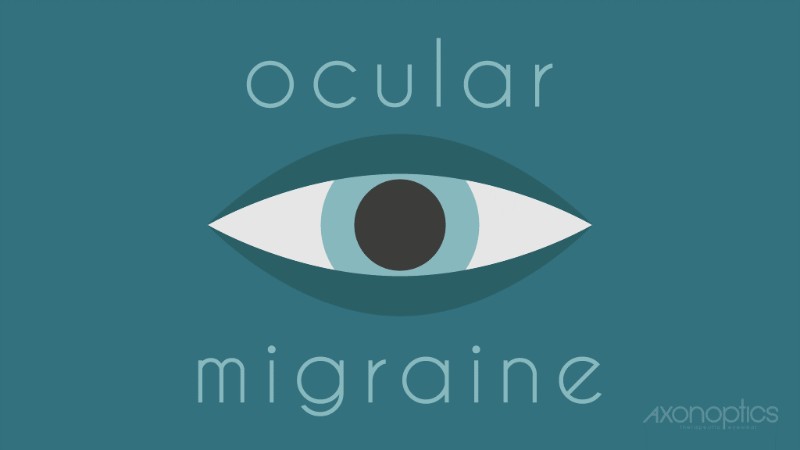While the throbbing, insistent pain of most migraine events might be the overriding symptom for most, a relatively small portion of migraine sufferers – about one of every 200 – will experience visual symptoms without headache. This is commonly known as an ocular migraine.
So, what the heck is an ocular migraine and why do they occur? How do you know if you’re having one, and what you can do about it? This article will give you the low-down on all of it. Let’s dive in.
What Is Ocular Migraine?
An ocular migraine causes temporary vision loss or visual disturbance. It usually lasts under an hour, and usually affects just one eye.
Ocular migraine may be called optical migraine, visual migraine, retinal migraine, ophthalmic migraine, or visual aura. But the official name and classification according to institutions like the American Migraine Foundation and International Headache Society is migraine aura without headache. We’ll just call it ocular migraine. Yeah, that’s easier.
At Axon Optics, we get a lot of questions about ocular migraine. This has made us more aware that our precision-tinted lenses can help a wide reader base. Our commitment to providing the most current research findings on migraine-related disorders includes ocular migraine.
Lots of people who wear our glasses have seen a reduction or other improvements in their ocular migraine. We hope this article addresses some of your questions about ocular migraine.
Ocular Migraine Symptoms
Ocular migraine symptoms are visual in nature, and can include the following:
Appearance of twinkling, shimmering, or flickering light

Starbursts or zigzagging lines in your visual field

Blind spots (areas where vision is reduced or completely absent)

Tunnel vision

Temporary blindness
Image coming soon…
Many people only experience the symptoms above. For others, the visual symptoms also come with symptoms of migraine having nothing to do with head pain, including:
- Nausea
- Fatigue
- Confusion
- Irritability
Especially if you’ve never had one before, ocular migraine attacks can be downright frightening. Suddenly seeing these visual symptoms and not knowing why could really freak you out. You might fear you’re having a serious vision problem, or even a stroke.
Ocular migraine doesn’t receive nearly as much attention in medical literature and the media as painful migraine does, so it’s less familiar to most people.
Ocular Migraine, But No Pain? Here’s Why.
The medical community hasn’t quite figured out why some migraine sufferers may experience visual symptoms alone, without a headache either before or after.
What researchers do know is that light plays a role in most migraine events, and that this role can be played out even in patients who are blind. Yeah, you read that right. This indicates that additional nerve pathways play a role in migraine symptoms — pathways not even associated with vision.
This revelation also underscores the need for further research into migraine. Fortunately, today’s science has begun focusing on migraine pain and aura as two disparate events that can be studied separately.

Ocular Migraine Is Not Migraine With Aura
Ocular migraine symptoms are sometimes confused with migraine with aura, but they aren’t the same thing.
Migraine with aura refers to visual symptoms that occur before a headache and other migraine symptoms develop. This can begin up to several hours before onset of a migraine. Aura occurs in about 20 percent of all migraine sufferers, and most of those people go on to develop the throbbing, deep headache usually associated with the migraine experience.
With ocular migraine, or migraine aura without headache, visual symptoms still occur, but they are not followed nor accompanied by the headache.
Ocular Migraine Is Not Retinal Migraine
Sometimes people use the terms retinal migraine and ocular migraine interchangeably, but they are two different conditions. While they do share some symptoms, the nature of the attack itself and how the vision is affected are the most obvious ways to distinguish the two.
Retinal Migraine vs Ocular Migraine
- Retinal migraine – Vision disturbance occurs in both eyes which may lead to temporary blindness.
- Ocular migraine – Vision disturbance occurs in just one eye and may include zig zag lines, blind spots, flashing lights, visual blurring, “seeing stars,” or visual dimming.
There has long been controversy in the medical community about retinal migraine. Some researchers question whether it’s a valid condition or a misdiagnosis of something else.
Ocular migraine, on the other hand, has been widely accepted as a type of migraine. There is evidence, though, that there are two distinct conditions, each with its own symptoms.
What Causes Ocular Migraine? Triggers and Risk Factors
Whether your migraine attack is painful in nature, ocular without pain, or both, the cause is likely the same.
Not that long ago, researchers believed migraine attacks were related to problems with blood flow in the brain. Thankfully, more recent advances have led to a much more comprehensive understanding. We now know a lot more about migraine disease and the underlying processes that cause it.
Today, medical researchers and doctors believe migraine attacks are caused by an interaction between the nerves and the blood vessels in the brain, classifying them as neurovascular events. These events occur when nerve activity causes changes in the circulation in the brain.
Whether these neurovascular events bring on a headache or not, any type of migraine can be triggered by the same specific stimuli across the board. These may include:
- Illness
- Stress
- Allergies
- Food sensitivities
- Sleep problems
- Exposure to bright lights or loud noises
- Caffeine or alcohol consumption
Sometimes, there are specific risk factors that also contribute to ocular migraine. If you can’t identify specific triggers, consider whether you have some of these risk factors.
Risk Factors for Ocular Migraine
There are several factors that could have an impact on your risk for ocular migraine.
- Gender – Ocular migraine tends to be more prevalent in women than men
- Age – Ocular migraine typically occurs in people under age 40.
- Genetics – A family history of ocular migraine, migraine, or chronic headache
- History of Migraine – A personal history of migraine or chronic headache
-
Medical Conditions
- High blood pressure
- Hardening of the arteries
- Epilepsy
- Lupus
-
Lifestyle factors
- Smoking
- High stress
- Physical exertion (overheating, dehydration, etc.)
- Oral contraceptives
What Causes Visual Aura?

Hopefully, this leads to more studies focusing on ocular migraine (migraine aura without headache) to improve our understanding of these events.
No matter what the underlying cause of these relatively unusual and “painless” migraine attacks, the symptoms of ocular migraine can be just as disruptive to daily activities. They can be just as worrisome and stressful for those who suffer from them.
Even though there may be no associated pain, ocular migraine still requires optimal treatment to make them less frequent and less severe.
Diagnosing Ocular Migraine
Historically, diagnosing ocular migraine has been difficult. Unfortunately, this has also made getting appropriate and effective treatment more complicated.
Just as most patients associate migraine with headache, many healthcare practitioners also have a low level of awareness of the symptoms of ocular migraine when it occurs without the headache.
In the absence of headache symptoms, some healthcare practitioners seek other possible causes for visual symptoms. They may investigate eye problems like retinal detachment or dry eye, eye disease such as diabetic retinopathy, or even chronic stress. In many cases, misdiagnosis leads to delayed care.
When to See Your Doctor for Ocular Migraine
Even though the symptoms can be scary, in the vast majority of cases ocular migraine attacks are harmless. They don’t typically last very long, and then you can get on with your day.
It’s rare for ocular migraine to indicate a serious health condition, such as carotid artery disease or risk for stroke. This is why it’s critical to seek medical attention if:
- Your eyesight suddenly deteriorates
- You suddenly lose your eyesight for the first time
If this happens to you, see your ophthalmologist or optometrist ASAP for a comprehensive eye exam. They can help you diagnose and treat any underlying conditions that could be related to your ocular migraine.
Treatment and Prevention
Several medications have been developed to aid in the treatment of migraine symptoms. Some could potentially prevent migraine attacks from occurring or reduce their severity. Many of these drugs are used to treat ocular migraine as well.
However, finding the right combination of medications has proven problematic. For some people these medications are ineffective, and long-term use may cause side effects, including rebound headaches.
More recently, studies have focused on the effects of light as a migraine trigger. They’ve also studied using special lenses to filter out the light wavelengths related to increased migraine activity. Studies dating back to the mid-1980s have demonstrated that specially-tinted lenses may help people living with migraine.
Axon Optics is a leading provider of Avulux Migraine & Light Sensitivity lenses. If you have migraine aura with or without headache, Axon Optics powered by Avulux Migraine & Light Sensitivity lenses could be just what the doctor ordered for helping you manage the impact of light on your life. To learn more about Axon Optics, explore our website, like us on Facebook, or ask your eye doctor if Avulux Migraine & Light Sensitivity lenses are right for you.
References: This article is based on academic articles and interviews
1. NHS Choices, NHS, www.nhs.uk/conditions/retinal-migraine.
2. “‘Retinal Migraine’ Is an Oxymoron : Journal of Neuro-Ophthalmology.” LWW, Oxford University Press.
3. “Anonymous (Not Verified).” Arizona RETINA Project, azretina.sites.arizona.edu/.
4. Carson-DeWitt, Rosalyn, and Colleen Doherty. “What to Know About Retinal and Ocular Migraines.” Verywell Health, Verywellhealth, www.verywellhealth.com/.
5. Doyle, E, et al. The British Journal of Ophthalmology, Copyright 2004 British Journal of Ophthalmology, Feb. 2004, www.ncbi.nlm.nih.gov/
pmc/articles/PMC1772006.
6. “Most Cases Labeled as ‘Retinal Migraine’ Are Not Migraine : Journal of Neuro-Ophthalmology.” LWW, Oxford University Press, journals.lww.com/jneuro-ophthalmology.
7. Nichols, Hannah. “Retinal Migraine: Causes, Symptoms, and Treatment.” Medical News Today, MediLexicon International, www.medicalnewstoday.com/
articles/314917.
“Ocular Migraines Explained – All About Vision.” All About Vision, www.allaboutvision.com/conditions/
ocular-migraine.htm.





